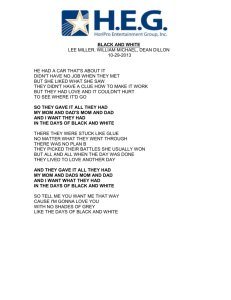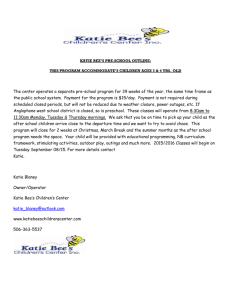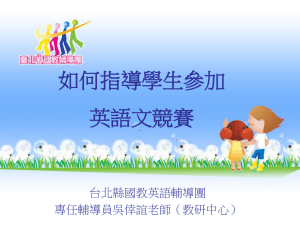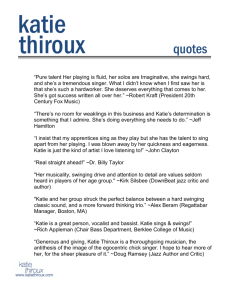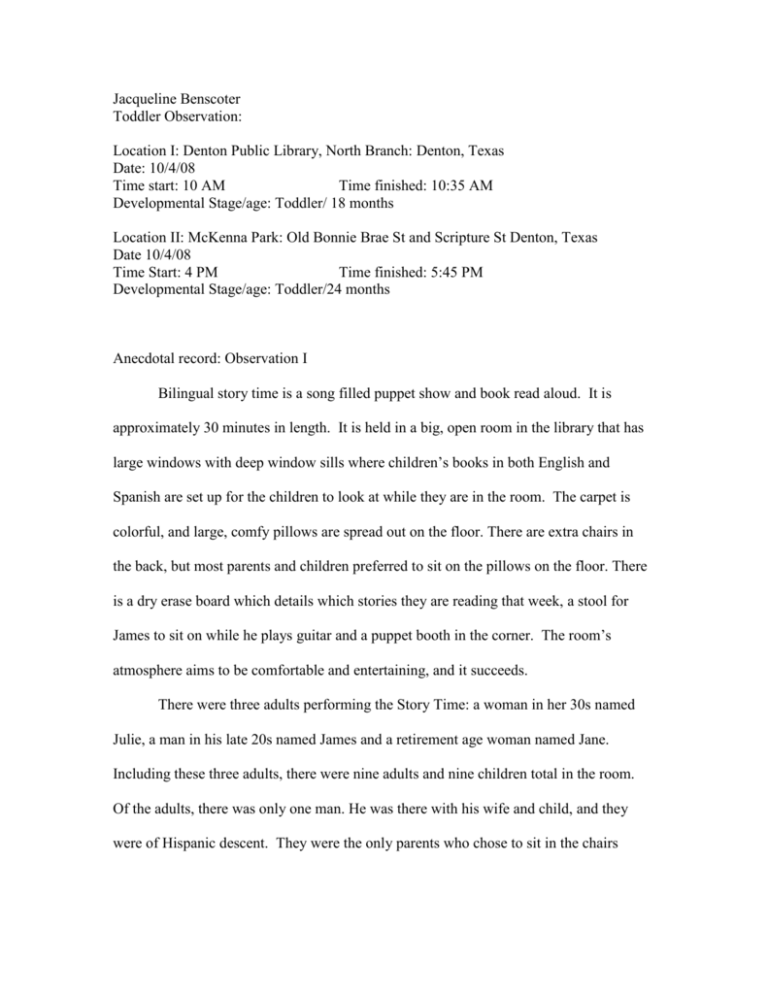
Jacqueline Benscoter
Toddler Observation:
Location I: Denton Public Library, North Branch: Denton, Texas
Date: 10/4/08
Time start: 10 AM
Time finished: 10:35 AM
Developmental Stage/age: Toddler/ 18 months
Location II: McKenna Park: Old Bonnie Brae St and Scripture St Denton, Texas
Date 10/4/08
Time Start: 4 PM
Time finished: 5:45 PM
Developmental Stage/age: Toddler/24 months
Anecdotal record: Observation I
Bilingual story time is a song filled puppet show and book read aloud. It is
approximately 30 minutes in length. It is held in a big, open room in the library that has
large windows with deep window sills where children’s books in both English and
Spanish are set up for the children to look at while they are in the room. The carpet is
colorful, and large, comfy pillows are spread out on the floor. There are extra chairs in
the back, but most parents and children preferred to sit on the pillows on the floor. There
is a dry erase board which details which stories they are reading that week, a stool for
James to sit on while he plays guitar and a puppet booth in the corner. The room’s
atmosphere aims to be comfortable and entertaining, and it succeeds.
There were three adults performing the Story Time: a woman in her 30s named
Julie, a man in his late 20s named James and a retirement age woman named Jane.
Including these three adults, there were nine adults and nine children total in the room.
Of the adults, there was only one man. He was there with his wife and child, and they
were of Hispanic descent. They were the only parents who chose to sit in the chairs
while their daughters sat on pillows. There were nine children, two boys and seven girls
that ranged in age from age 18 months to 5 years of age.
The observation subject Maddie is approximately 18 months of age, and there was
another little girl who was near her age present. Most of the other children were a bit
older and appeared to range in age from ages 3 to 5.
Story Time opened with a song, Hello Everybody, where children were
encouraged to sing along and perform hand gestures including clapping. Maddie danced
and clapped along, but was generally unable to perform some of the other hand gestures.
She stomped her feet, looked back at her mom and grinned. Then they sang Buenos Dias,
a song to the tune Frere Jacques in Spanish. Maddie pointed at the window, danced on
the pillow with help from mom and sits down.
The first book they read was Going on a Bear Hunt. Maddie crawled onto the
pillow and paid attention to the reader for a bit, responding to the rhythm of the text by
swaying back and forth. She went over to the window sill holding books and grabbed
one in each hand, demonstrating a strong pincer grasp which will help her in later
writing. She brought them back to her mom and they looked at pictures together.
The next activity was Open, Shut them, a finger play song that was to the tune
Frere Jacques, where children were asked to open and close their fingers, clap and put
their hands on their laps according to instruction. Maddie danced and made hand gestures
but not in any rhythm or order. Similarly Maddie did not completely follow along during
the next song finger play activity, which was a bilingual counting song called ten little
fingers, where they counted in English and Spanish to the tune of the popular song Ten
Little Indians. Maddie was not able to follow the hand gestures, but she danced with the
other little girl her age.
At one point as they were transitioning into the next book, Maddie turned around,
looked at me and smiled. She then slid forward on her bottom away from her mother but
not too far away. Maddie made eye contact with her mother and crawled back over to
her. During the next book, which was titled Margaret and Maria, Maddie pointed at all
the books next to her mom and said over and over again, “books, books!” Maddie sat
with her back to the performers so she could interact quietly with another older child.
She moved on to the little girl her age, and they interacted quietly for a few moments
before Maddie made her way back to her mom and her pillow. She pulled a book over to
her so she and her mom could look at more books.
The next activity was another song, where the children and parents were asked to
stand. To the tune of Row, Row, Row Your Boat, they sang a song with hand gestures
called Roll, Roll, Roll Your Hands. Maddie danced and clapped, but the other hand
gestures were too fast for her to grasp and imitate, but she grinned the whole time. The
next book was called Playground Day and it was about a trip to the playground in which
the main character encounters many different kinds of animals at the playground. It was
here they incorporated the puppet booth and several animal puppets including a monkey,
squirrel, penguin and mouse. All of the children were rapt, and Maddie sat right up front
and shouted “elephant, look!” when the elephant came out, and “hi frog” when the frog
appeared.
The closing songs were called the More We Read Together, which utilized
modified sign language and Buenas Noches, which was again to the tune of Frere
Jacques. Maddie tried to follow along but she and her age related friend danced and
waved their hands instead. She put the books back on the window sill where she got
them, took her mom’s hand and left the room. The other children, including the friend
her age, stayed a few moments longer to pet the puppets and strum the guitar. Maddie and
her mother were choosing books to take home, and they took their time. Maddie looked
at several books before choosing two they wanted to take home and they went to the
checkout desk.
Location II: McKenna Park
McKenna Park is a large, colorful playground at the corner of Old Bonnie Brae
Street and Scripture Street. It’s got modern, colorful playground equipment that is
designed for safety, and a wood chip floor. I performed my pbservation at 4 pm, and
there were 14 children: 3 girls about 2 or 3 years old, one 5 year old boy, 2 girls about 7,
1 baby, and 3 girls about 5 years old. There were also 11 adults watching their children
and two teenagers playing on the basketball court adjacent to the playground. Katie,
observation subject two, was playing at McKenna Park with her family. She was at the
park with her mother, and they played on the playground until her father and sister came
by. While they waited for dad and sister, Katie and mom played on the hard and soft
bridges that connect activity platforms. The platforms have slides coming off of them,
and objects to spin, twist and explore at the top. Katie’s mom helps her step down from
the platform to the soft bridge. It is a wide step, and she crouches down as if she will do
it herself, but hesitates. Mom helps her down, where she lingers in the middle. She pokes
her head through the rails to say something to mom. They play a peekaboo type game.
She crosses the bridge to the other side, holding the rail with her right hand.
Katie watches older children attempt monkey bars and her mom helps her down
from the platform. Katie runs to the ladder to the monkey bars to try to climb it. She tries
to climb a short ladder multiple times but is unsuccessful. Her grasp on the bar above her
is strong, but her feet won’t stay put. She falls twice, and tries again a third time. She
manages to stay on the first rung for a moment, but her feet slip again, and mom puts her
on the top (fourth) rung and holds her there. Mom takes her down, and they walk out of
fenced area. Katie notices a tree nearby, and she touches the bark. Mom says “tree,” and
when she touches the bark again, mom says “bark.” Katie touches it and says “ouch.” She
walks over (with mom) to the picnic table where they will have a picnic dinner.
Katie swings both arms while walking, and runs to mom at the table. She
wanders off for a minute but not too far, and comes back to the table and picks up a baby
doll and starts walking towards the playground again. She turns back to look and wave at
mom and says “come on.” She continues on her way, and looks back again, and mom
follows. Katie watches another child her age about to cross the soft bridge. The little girl
is blond haired, and she says hello and asks Katie her name. Katie waves back, but hides
in mom’s legs but turns back to look at the little girl again. She is looking back and forth
between a one on one basketball game in the adjacent court and the other child, with
mom’s pant leg clutched between her fingers.
Katie’s sister and father arrive and her sister runs across the grass to the
playground. Katie smiles at them and swings her arms while she walks to the
playground. She stops to wave at the other little girl her age with her right hand and she
observes the basketball game some more. Katie climbs on the first step of the platform
she’s been playing on and up the four other steps. She crosses the platform to wave at
her sister who’s on the other side. The other child her age is also on the platform, and
Katie’s mom helps her to get onto the soft bridge. The children do not interact.
She makes it to the other side of the bridge and reaches for mom to get her down.
Mom helps her down. She goes back up the steps, holding the rail with her right hand.
Mom helps her take the step down to the soft bridge, she crosses the bridge and peeks
through the bars to talk to mom and dad. She approaches the slide and mom offers to
catch her but she refuses. She goes across the bridge to the platform on the other side and
peers down the slide. Dad offers to catch her but she declines again, instead asking that
he help her down. Mom goes to the table to unpack the picnic while Katie and dad go to
the infant swings. Dad puts Katie in the swing and they swing for a few minutes until
dinner is ready.
Analysis:
The room set up at the library, with books on the windowsill, was a great idea.
Children that age have shorter attention spans, so it was good they had something else to
look at to prevent behavior problems. I noticed the younger children especially got up
several times to look at the books, interact with each other and do other things. Since they
had that freedom, none of the children fidgeted, cried, or misbehaved. In other activities
where children are expected to sit still for longer periods can prove disastrous. The park
was a great mix of developmentally diverse equipment, so children of every age and
ability had a number of things they could play on.
Maddie is where she needs to be in all observable areas of development. She has
the motor skills of an 18 month old and she has the short, one or two word utterances that
indicate she is on track to pick up more and more words every day. Although Katie had
difficulties with certain aspects of the playground, her difficulties were age appropriate.
Katie is a bit small for her age, but appears otherwise healthy.
Maddie’s social development is enough that she should have no trouble making
friends in school. She is developing social competence, in which she learns the steps it
takes to make friends, which will help her succeed academically and socially (Fields &
Fields, 2006, p. 57). She is sociable with her peers and children older than her, and she is
willing to take risks by scooting away from her mom but not too far away. She explores
her world, and knows she is safe. She is in the Autonomy vs. Shame and Doubt stage of
development, where she is explorative and learning her own will and the boundaries of
her environment. If successful in this stage, Maddie will enter the next stage of
development, Initiative vs. Guilt with autonomy to do things on her own and the trust of
her caregivers (Morrison, 2007, p. 126). Her mother allows her to wander, explore and
learn things on her own. When Maddie wandered off, mom stayed seated near her
pillow but kept an eye on her. Katie, on the other hand, is considerably shyer than
Maddie when it comes to other children. She observed children, but was reluctant to
interact with them. This behavior is not likely to be problematic yet, especially if Katie
does not get to interact with people she is not already familiar with on a regular basis.
However, her parents will want her to begin interacting with children her age, or she
could start preschool or Kindergarten without the social skills she needs to be successful.
Both girls appear to be securely attached to their mothers (and in Katie’s case,
family) and from all the dancing and smiling Maddie did, I would say that she is an easy
temperament child. She didn’t mind wandering away from her mother, the changes in the
routine, or the other people around her. In fact, she seemed very much like she was
enjoying herself. Katie also appears of an easy temperament, because although she
seemed shy, she didn’t seem to be upset by changes in her environment or unusually
fussy. A slow to warm up child, according to early childhood expert Dr. George S.
Morrison, from the University of North Texas, would display “low activity level, slow to
adapt, withdrawal from new stimuli, negative mood, and a low intensitiy of response,”
(Morrison, 2007, p. 256). Katie did not display these characteristics, she was just shy.
Reflection:
Bilingual Story Time is a valuable resource for the community. It is the literacy
rich environments such as this one that foster oral language development and other skills
that help ensure success in reading and writing. Maddie is not even out of diapers and
she is experiencing two languages, two cultures and a rich literary environment. By
understanding how to hold a book and how to turn pages, she already expresses book
oriented concepts, which is part of a larger set of literacy competencies called concepts
about print, (Tompkins, 2007, p. 43). Concepts about print and oral language competence
are common indicators of future academic success (Tompkins, 2007, p. 43). Some
students enter Kindergarten or Pre K without knowing much about books, but Maddie
will not be one of these children. She clearly loves books and stories and has a good
chance of being a successful reader and writer.
Places to play are essential for physical and emotional health of children. Studies
have shown that physical activity affects intellectual development, so in essence, parks
and recess make kids smarter (Fields & Fields, 2006 p. 24). Katie could benefit from a
playgroup in which she regularly interacts with people other than her family, but her
stranger anxiety is normal for her age. She could also benefit from an environment in
which she was allowed more independence; I noticed her parents helping her more than
they should for her to develop autonomy. They risk her doubting her abilities if they do
too much for her and don’t encourage her to challenge herself. She was reluctant to go
down the slides, even when mom or dad offered to catch her, which is a reluctance to
take risks. She may just be afraid of slides, and that is acceptable, too. An environment
where she was able to take safe risks would be great for her, though, as would play
independently and with other children her age.
References:
Morrison, G. S. (2007). Early childhood education today. (10th ed). Upper Saddle River,
New Jersey. Pearson Prentice Hall.
Fields, M.V. and Fields, D. M. (2006). Constructive guidance and discipline: Preschool
and primary education. (4th ed). Upper Saddle River, New Jersey. Pearson
Prentice Hall.
Tomkins, G. (2007). Literacy for the 21st century: Teaching reading and writing in
prekindergarten through grade 4. (2nd ed). Upper Saddle River, New Jersey.
Pearson Prentice Hall.


